Abstract
Caffeine (5 mg kg-1) was administered orally to two healthy, non-smoking subjects on three separate occasions--before, and during therapy with the xanthine oxidase inhibitor allopurinol at doses of either 300 or 600 mg daily. Plasma and urinary levels of methylxanthines, endogenous oxypurines and allopurinol and its metabolite oxypurinol were measured using h.p.l.c. analyses. Allopurinol treatment caused a specific, dose-dependent inhibition of the conversion of the caffeine metabolite 1-methylxanthine (1X) to 1-methyluric acid (1U). A good correlation was observed in both subjects between the urinary 1U/1X molar ratio and the ratio of endogenous urate to hypoxanthine + xanthine at the different allopurinol doses, supporting the proposal that the 1U/1X molar ratio after caffeine intake provides an in vivo index of xanthine oxidase activity in man.
Full text
PDF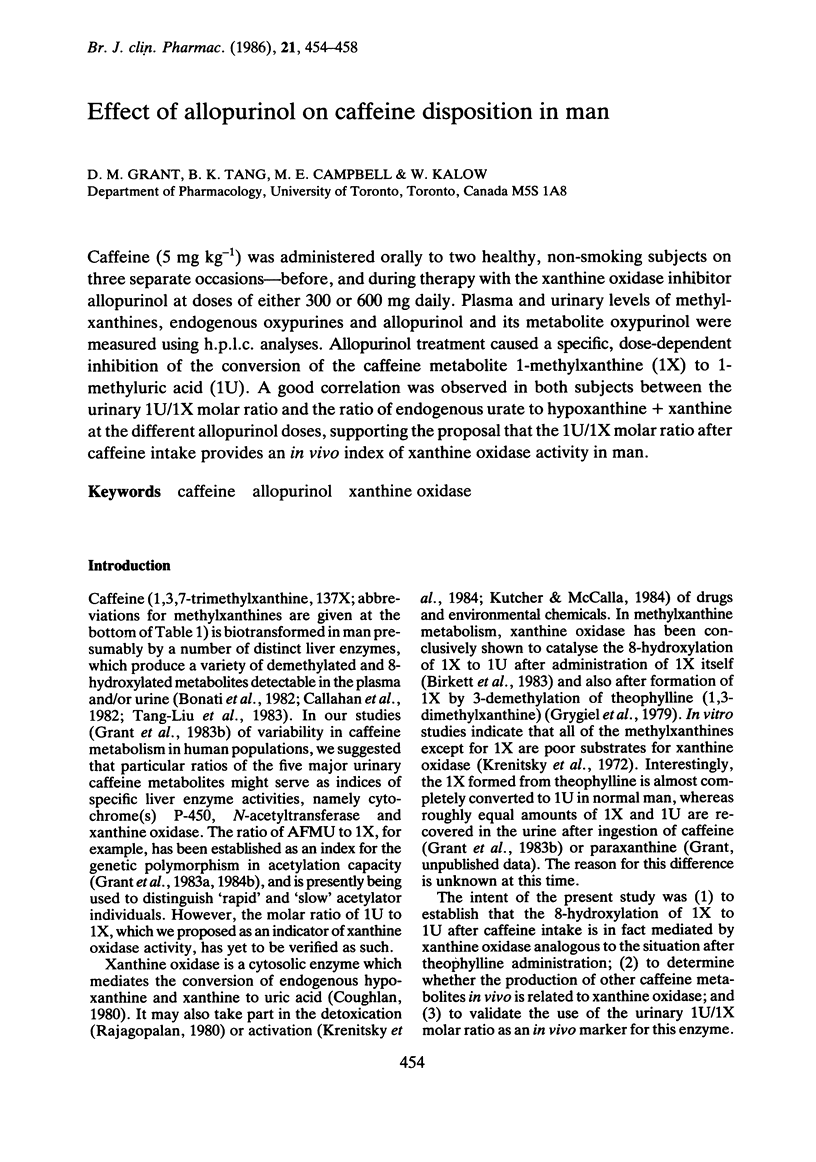
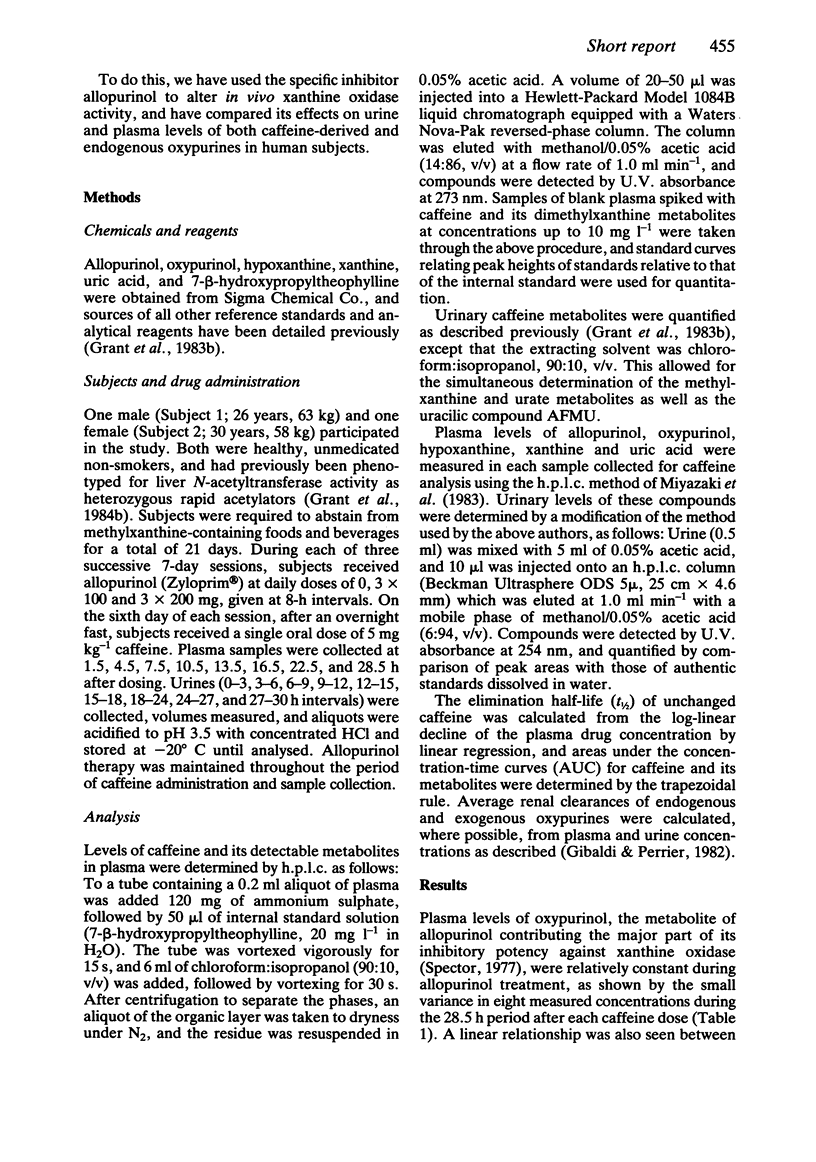
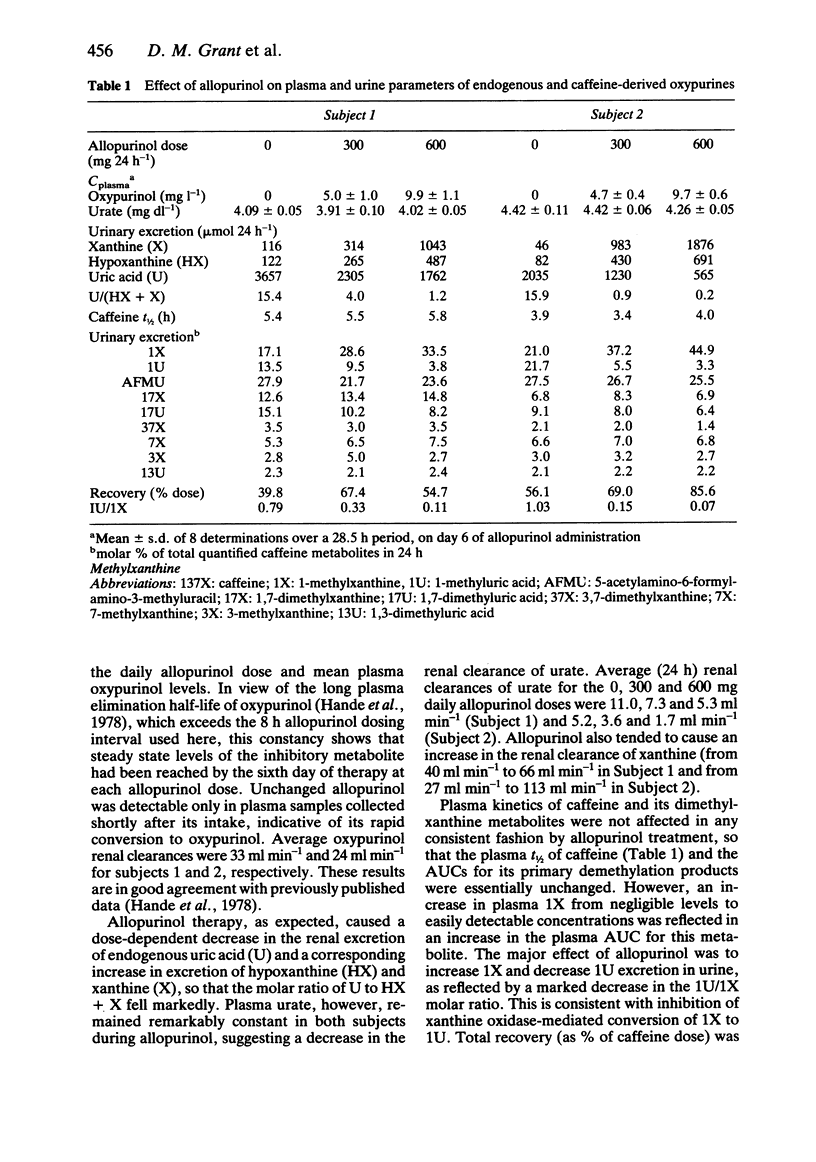
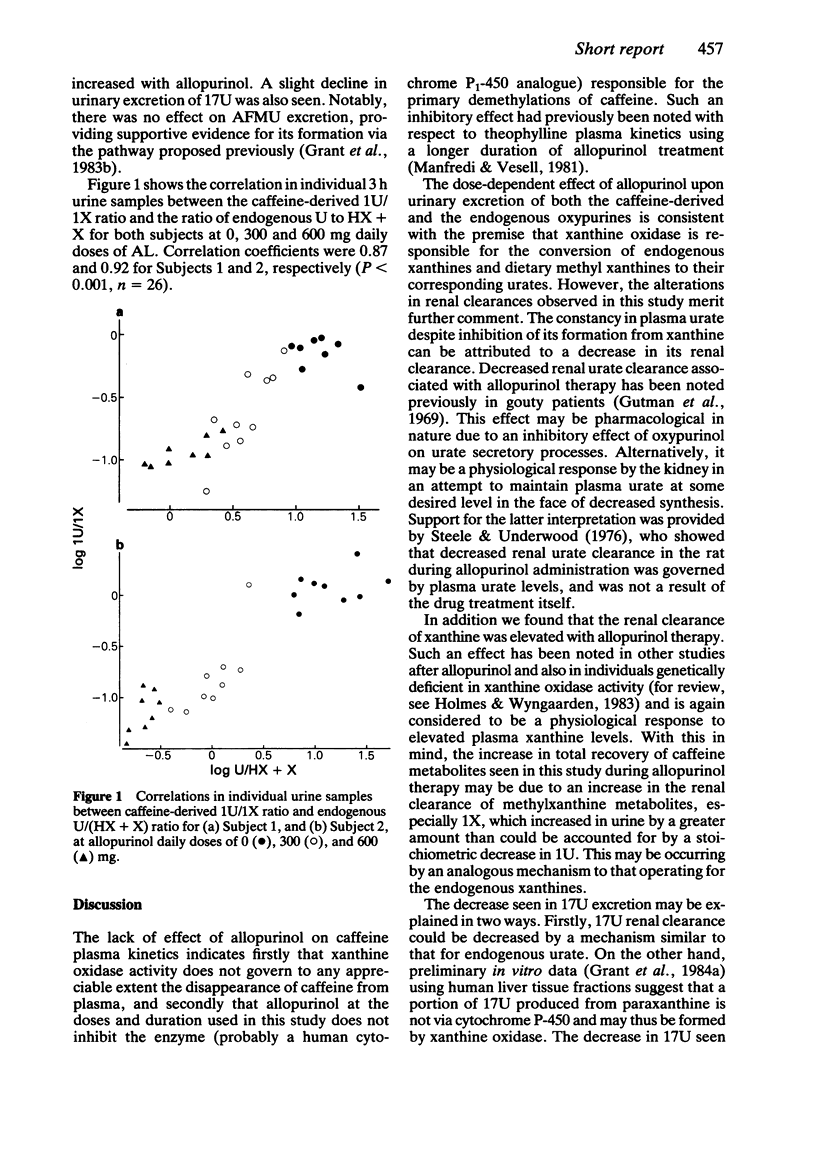
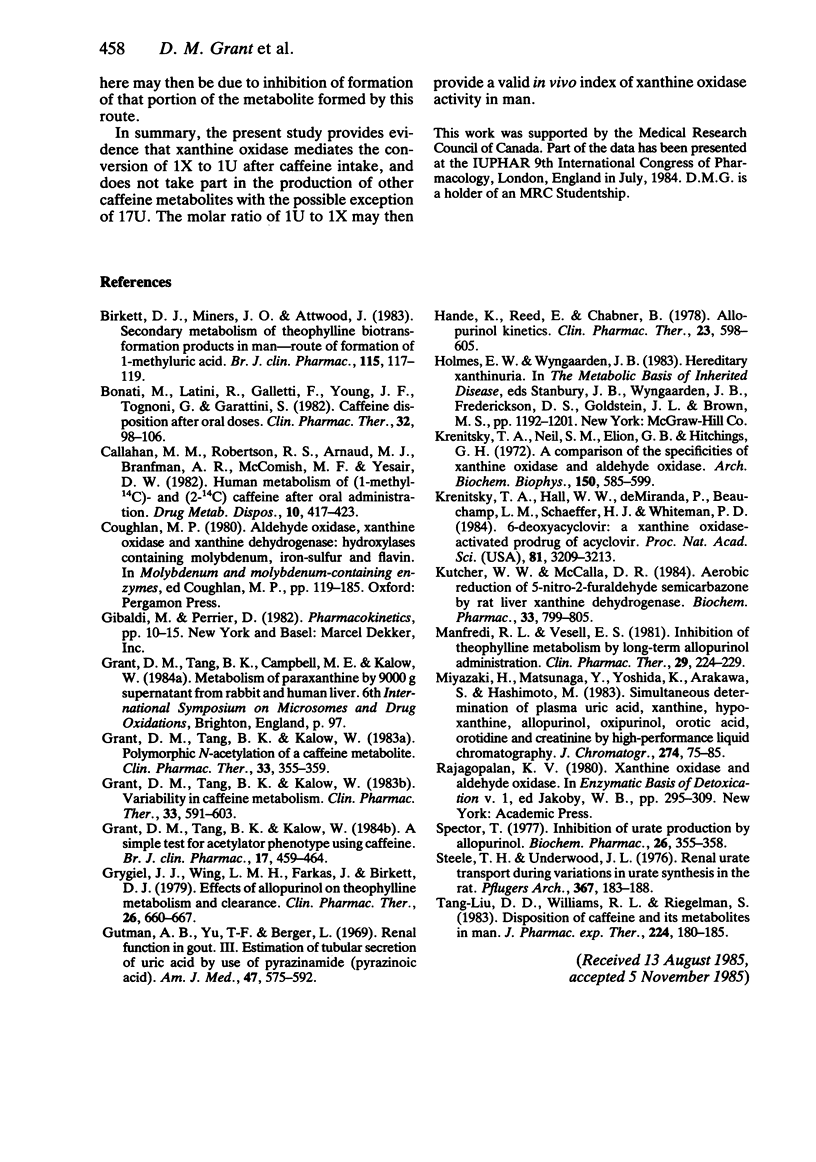
Selected References
These references are in PubMed. This may not be the complete list of references from this article.
- Birkett D. J., Miners J. O., Attwood J. Secondary metabolism of theophylline biotransformation products in man--route of formation of 1-methyluric acid. Br J Clin Pharmacol. 1983 Jan;15(1):117–119. doi: 10.1111/j.1365-2125.1983.tb01475.x. [DOI] [PMC free article] [PubMed] [Google Scholar]
- Bonati M., Latini R., Galletti F., Young J. F., Tognoni G., Garattini S. Caffeine disposition after oral doses. Clin Pharmacol Ther. 1982 Jul;32(1):98–106. doi: 10.1038/clpt.1982.132. [DOI] [PubMed] [Google Scholar]
- Callahan M. M., Robertson R. S., Arnaud M. J., Branfman A. R., McComish M. F., Yesair D. W. Human metabolism of [1-methyl-14C]- and [2-14C]caffeine after oral administration. Drug Metab Dispos. 1982 Jul-Aug;10(4):417–423. [PubMed] [Google Scholar]
- Grant D. M., Tang B. K., Kalow W. A simple test for acetylator phenotype using caffeine. Br J Clin Pharmacol. 1984 Apr;17(4):459–464. doi: 10.1111/j.1365-2125.1984.tb02372.x. [DOI] [PMC free article] [PubMed] [Google Scholar]
- Grant D. M., Tang B. K., Kalow W. Polymorphic N-acetylation of a caffeine metabolite. Clin Pharmacol Ther. 1983 Mar;33(3):355–359. doi: 10.1038/clpt.1983.45. [DOI] [PubMed] [Google Scholar]
- Grant D. M., Tang B. K., Kalow W. Variability in caffeine metabolism. Clin Pharmacol Ther. 1983 May;33(5):591–602. doi: 10.1038/clpt.1983.80. [DOI] [PubMed] [Google Scholar]
- Grygiel J. J., Wing L. M., Farkas J., Birkett D. J. Effects of allopurinol on theophylline metabolism and clearance. Clin Pharmacol Ther. 1979 Nov;26(5):660–667. doi: 10.1002/cpt1979265660. [DOI] [PubMed] [Google Scholar]
- Gutman A. B., Yü T. F., Berger L. Renal function in gout. 3. Estimation of tubular secretion and reabsorption of uric acid by use of pyrazinamide (pyrazinoic acid). Am J Med. 1969 Oct;47(4):575–592. doi: 10.1016/0002-9343(69)90188-0. [DOI] [PubMed] [Google Scholar]
- Hande K., Reed E., Chabner B. Allopurinol kinetics. Clin Pharmacol Ther. 1978 May;23(5):598–605. doi: 10.1002/cpt1978235598. [DOI] [PubMed] [Google Scholar]
- Krenitsky T. A., Hall W. W., de Miranda P., Beauchamp L. M., Schaeffer H. J., Whiteman P. D. 6-Deoxyacyclovir: a xanthine oxidase-activated prodrug of acyclovir. Proc Natl Acad Sci U S A. 1984 May;81(10):3209–3213. doi: 10.1073/pnas.81.10.3209. [DOI] [PMC free article] [PubMed] [Google Scholar]
- Krenitsky T. A., Neil S. M., Elion G. B., Hitchings G. H. A comparison of the specificities of xanthine oxidase and aldehyde oxidase. Arch Biochem Biophys. 1972 Jun;150(2):585–599. doi: 10.1016/0003-9861(72)90078-1. [DOI] [PubMed] [Google Scholar]
- Kutcher W. W., McCalla D. R. Aerobic reduction of 5-nitro-2-furaldehyde semicarbazone by rat liver xanthine dehydrogenase. Biochem Pharmacol. 1984 Mar 1;33(5):799–805. doi: 10.1016/0006-2952(84)90465-9. [DOI] [PubMed] [Google Scholar]
- Manfredi R. L., Vesell E. S. Inhibition of theophylline metabolism by long-term allopurinol administration. Clin Pharmacol Ther. 1981 Feb;29(2):224–229. doi: 10.1038/clpt.1981.36. [DOI] [PubMed] [Google Scholar]
- Miyazaki H., Matsunaga Y., Yoshida K., Arakawa S., Hashimoto M. Simultaneous determination of plasma and urinary uric acid, xanthine, hypoxanthine, allopurinol, oxipurinol, orotic acid, orotidine and creatinine by high-performance liquid chromatography. J Chromatogr. 1983 May 13;274:75–85. doi: 10.1016/s0378-4347(00)84410-2. [DOI] [PubMed] [Google Scholar]
- Spector T. Inhibition of urate production by allopurinol. Biochem Pharmacol. 1977 Mar 1;26(5):355–358. doi: 10.1016/0006-2952(77)90191-5. [DOI] [PubMed] [Google Scholar]
- Steele T. H., Underwood J. L. Renal urate transport during variations in urate synthesis in the rat. Pflugers Arch. 1976 Dec 28;367(2):183–188. doi: 10.1007/BF00585156. [DOI] [PubMed] [Google Scholar]
- Tang-Liu D. D., Williams R. L., Riegelman S. Disposition of caffeine and its metabolites in man. J Pharmacol Exp Ther. 1983 Jan;224(1):180–185. [PubMed] [Google Scholar]


